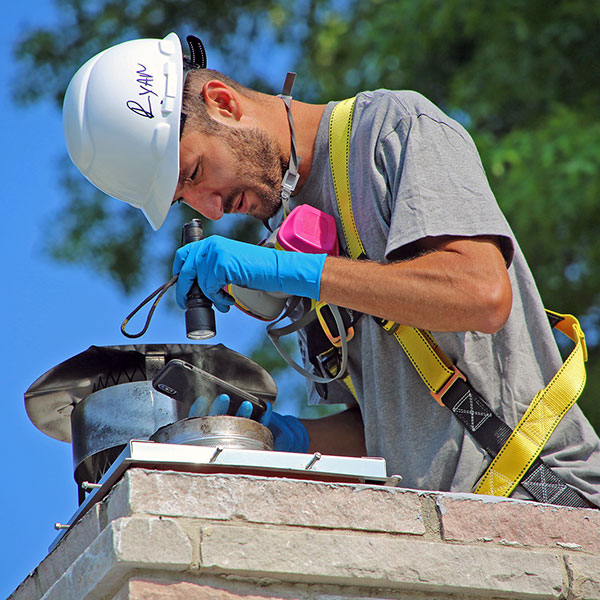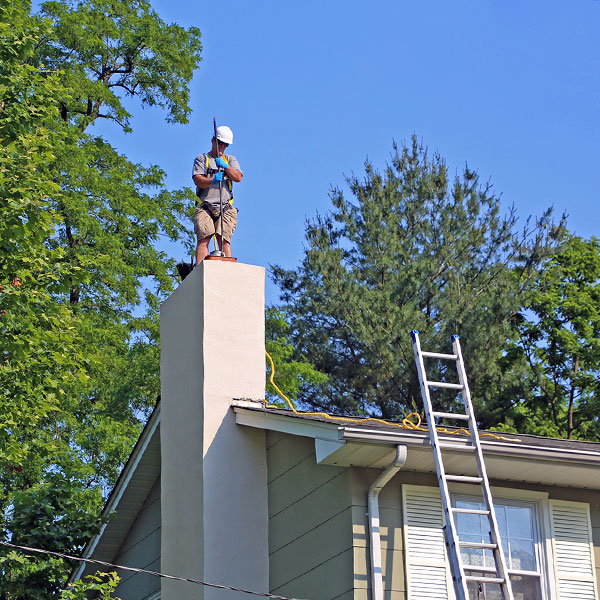Do All Chimney Flues Need Cleaning?
Many homeowners are choosing cleaner-burning gas and pellet fireplaces and heating stoves to heat their homes. They are convenient, offer a realistic fire burning experience, and require less maintenance. Although gas and pellet fuel produce less harmful pollutants than a traditional wood-burning fireplace, chimney cleaning is still necessary. Also, the Chimney Safety Institute of America recommends annual chimney inspections for homeowners using liquid or solid fuel heating appliances.
When using a gas fireplace or heating stove to warm your living space, most of the fumes vent up the flue. However, some of the residues also stick to the interior walls and other components in the chimney. The residue from combustion gases is acidic and corrosive. It can damage the flue liner and interior masonry, increasing the risk of fire and exposure to dangerous carbon monoxide fumes, not to mention expensive repairs.
Annual Fireplace and Chimney Inspections
 Regardless of whether you have a wood-burning, pellet, or gas fireplace, an annual inspection is necessary to ensure that the heating appliance is safe to operate and is venting correctly. The chimney technician will visually examine the chimney or vent for obstructions, excessive wear and tear, and other damages. The technician will also inspect the gas fireplace, including the gas connection, valves, ceramic logs, and other internal components for excessive wear, leaks, and damaged parts. The technician will recommend repair or replacement of worn or damaged parts that will increase safety and also prolong the lifespan of the appliance.
Regardless of whether you have a wood-burning, pellet, or gas fireplace, an annual inspection is necessary to ensure that the heating appliance is safe to operate and is venting correctly. The chimney technician will visually examine the chimney or vent for obstructions, excessive wear and tear, and other damages. The technician will also inspect the gas fireplace, including the gas connection, valves, ceramic logs, and other internal components for excessive wear, leaks, and damaged parts. The technician will recommend repair or replacement of worn or damaged parts that will increase safety and also prolong the lifespan of the appliance.
Chimney Cleaning
One of the benefits of annual chimney inspections is that the technician will let you know if cleaning the fireplace or vent is necessary.
Creosote
Creosote is a natural by-product of combustion that occurs in both wood-burning and gas fireplaces. Although gas fuel produces significantly less creosote, it will need to be removed periodically before it reaches an unsafe level. Excessive creosote increases the risk of fire and exposure to dangerous carbon monoxide fumes. An accumulation of 1/8” or more of creosote should be removed, according to the Chimney Safety Institute of America (CSIA).
Masonry
The interior masonry of a gas fireplace will need to be cleaned periodically to remove any corrosive gas residue covering the masonry. The residue, along with condensation in the chimney can cause efflorescence or white stains on the firebrick when cracks in the masonry bring the salt deposits to the surface.
 Debris
Debris
Sweeping the chimney is also necessary to remove any small animals, leaves, twigs, and other debris that are clogging the chimney or vent. Also, debris from deteriorating ceramic logs can block the vent and stick to the interior masonry walls.
Ventless Gas Fireplaces
Although ventless or vent free gas fireplaces are self-contained heating appliances that do not require a chimney or vent, the device does need an annual safety inspection and periodic maintenance and cleaning.
Ceramic Logs
It is a good idea to inspect the ceramic logs before igniting a gas fireplace. If there are any scratches or other types of damage, replace the log.
Carbon Monoxide
Carbon monoxide (CO) is a colorless, odorless, and tasteless gas that can have dangerous consequences.
Homeowners operating a gas, wood or pellet heating appliance should install a CO detector on every level of their home. An alert will sound if the CO exhaust from your fireplace or heating stove is reaching unsafe levels in your home.


